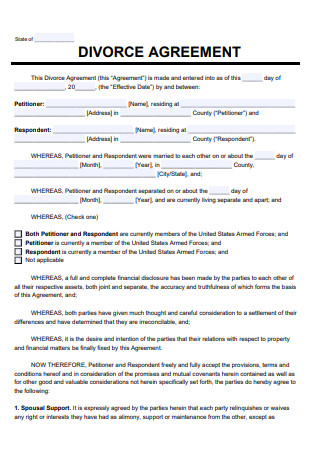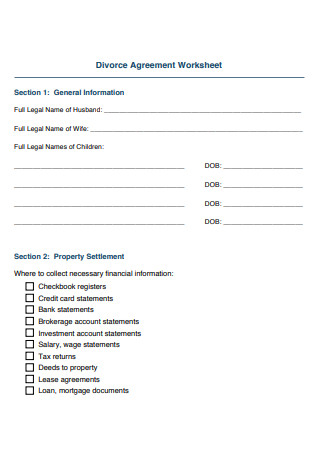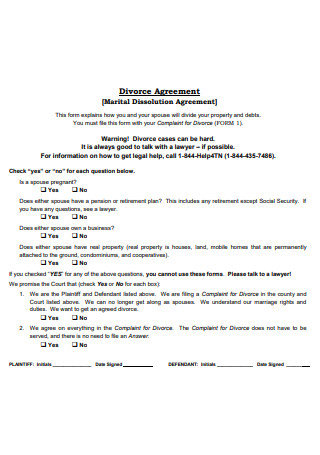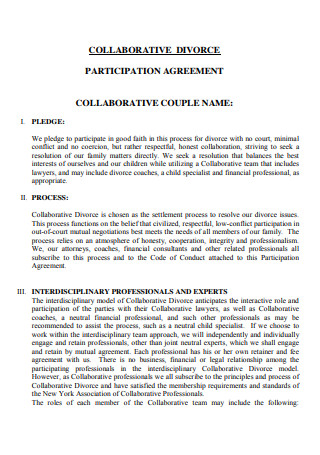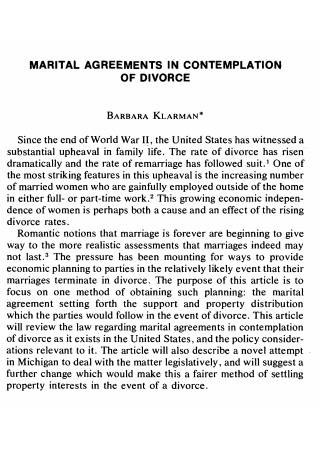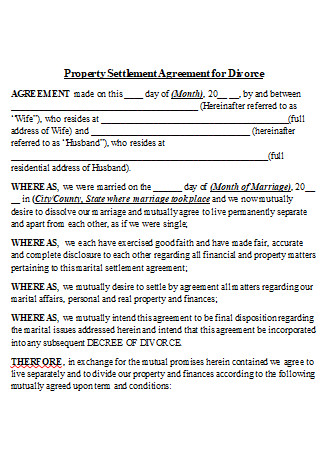5+ Sample Divorce Agreement
FREE Divorce Agreement s to Download
5+ Sample Divorce Agreement
What is a Divorce Agreement
When to Use a Divorce Agreement
Obstacles in a Divorce Agreement
Overcoming Obstacles in a Divorce Agreement
Key Components of a Divorce Agreement
FAQs
How do I write a divorce agreement?
What happens when one party refuses divorce?
What are the biggest reasons for divorce?
However, even for couples that have agreed to settle for a divorce, it isn’t exactly all rainbows just yet. The spouses still have to go through a process which can go easy depending on the kind of marriage the couple had and if the divore-to-be are willing to work together to settle to an agreement. This separation process usually begins with a Divorce Agreement that parties may use as they file for divorce and lessen the chances of having to need for a court intervention. In this article, we will discuss what a Divorce Agreement is, the many names it goes by, when one must use one and what constitutes a Divorce Agreement. You may refer to our Divorce Agreement Samples to get the general overview of what it looks like and what it should contain.
What is a Divorce Agreement
A Divorce Agreement is a crucial contract for your divorce case as it documents the agreements that both parties have arrived at and agreed upon regarding their divorce. This is usually made when a couple files for a divorce after meeting the state’s residency requirements which simply refers to the length of the time of your residency in a state that must be presented so as your divorce case will not be rejected. As written by Atty. Lina Guillen, residency requirements vary from state to state and some of these include longer residency periods spanning to a year like in New Jersey, South Carolina and West Virginia or shorter ones like 6 weeks as in the case of Nevada. In some states like Alaska, if you are a resident at the time the divorce is filed, then this passes as meeting the residency requirement.
Moreover, a Divorce Agreement that goes by many names like, Divorce Settlement Agreement, Separation Agreement or Separation and Property Settlement Agreement, Mediated Separation Agreement and Marital Settlement Agreement (MSA) among many others, records how a used to be married couple going in divorce will handle their family responsibilities covering as well topics such as child custody and support and spousal support. While a Divorce Agreement is only one step in the divorce process and while it oftentimes are incorporated prior to the divorce through a prenuptial agreement to prevent additional costs in the case that a couple does have to face a divorce, it should already function to decide the division of any marital assets and debts accumulated during the couple’s marriage which is why it is wise to have a lawyer represent you to clear out anything that may pose as a serious financial problem in the future that most times get overlooked especially if you go forward with the agreement along and with no professional consultations.
As mentioned previously, most divorce cases flow smoothly if the spouses are civil since a divorce agreement requires that assets, debts and marital property in general be identified and to come to a fair and equal distribution of joint assets, communication between both parties is a must. A civil setup would ensure that a fair agreement is made that both parties can sign on to submit and await the court’s judgement which is the only court intervention needed for this process. What follows should be a divorce decree effectively dissolving the marriage.
When to Use a Divorce Agreement
A Divorce Agreement can be used to file for a divorce when you and your spouse have already agreed on how to divide your properties and assets amongst each other or if the both of you are in the midst of negotiating over which property goes to who including child arrangements. Either way, this still has to go through court judgement who can approve of the agreements and ensure that it is of the best interest of the children involved.
Obstacles in a Divorce Agreement
Most times, divorce agreements cannot be settled because well, for one, both parties are in disagreement and refuse to work in collaboration due to the falling out that has occurred and the tension and emotional turmoil that comes along with it. This emotional upset is only one of the many reasons as to why a divorce agreement cannot be settled upon. Below are a few more reasons why being civil is easier said than done.
1. Emotional Upset and Conflict
As what was said, high levels of emotions hinders the ability to make a sound judgement and while it is normal to be in emotional conflict since divorce is a huge stressor in itself, it does slow down the divorce process and delay the stage where both parties can start moving forward.
2. Insecurity, Fear, Lack of Confidence and Unequal Bargaining Power
Divorce agreements require you to be as detailed as possible with your assets to equally divide it between yourselves. Now, this can cause one to feel low self-esteem because having to be knowledgeable and knowing how to effectively negotiate for yourself can be a scary situation especially when you know the implications of being lacking in information and the knowledge of the whole process. One can also feel insecure when they know that the other spouse might be bringing more to the family dinner table and grounds for child custody may be in favor of the spouse seeing that they are more financially adept to providing the needs of the children therefore this can expeditiously drain one’s self-confidence.
3. Ignorance and Misinformation
It is normal to not be informed of the legal system and how it works due to the complexity of its nature and because you might not be expecting to be in a situation that would require your vast knowledge of it but it does benefit you to avoid feelings of doubt, uncertainty, insecurity and incompetence should a situation arise, the situation being divorce settlement agreements. On the other hand, misinformation about the legal system can be more of a serious problem because one might believe their information to be true when in actuality it isn’t and subjective truth is something that you cannot easily turn nor can the distorted reality and expectations be overhauled. Which is why, both parties need to have consulted a legal counsel so as personal opinions hinged on emotions and personal perspectives of truth can be avoided.
Overcoming Obstacles in a Divorce Agreement
1. Agree on temporary arrangements.
While a Divorce Agreement can effectively be the terms of your divorce judgement, you don’t need to work out a final agreement down to the last detail just yet especially when emotions are high and logic and foresight is low. However, when you do come with temporary agreements they must be done in writing. Temporary agreements can firstly include short-term solutions that should prioritize the protection, security, and mental and emotional stabilities of the children especially if you have one. Ways to contact both of the parents must also be offered. If you as a couple lack children, temporary agreements can revolve around making payments on mortgages and debts.
2. Engage in a discussion and not an argument.
Although ideal in theory, to actually practice it will be hard. However, it is in your best interest to approach a divorce agreement with an open-mind. This way, things can be finished the way both parties would want to without causing a succession of disagreements. It also helps that agreements presented are rooted in what one needs and not out of vengeance or pettiness which is an understandable route with divorce cases as it is also a blow to one’s pride to have gone through it. But again, for both parties to start anew, it pays to look on the little bright side at the far end of the tunnel.
3. Consult a Legal Counsel.
Despite wanting to minimize legal activity, it is necessary to consult an attorney who specializes in divorce especially if you do not know much about what a divorce agreement entails and what it should mainly cover. Especially when stakes are high and your custody of the children is compromised, you want to be sure that the terms work in your favor so it’s actually encouraged to seek legal counsel if you have the financial means to do so.
4. Get support if you need it.
There should be no shame in asking for emotional support as you go through such a turbulent and in some cases, devastating process. This goes out for your children as well who should be as disoriented as you are. However, if you explain the situation to them in a way that they can best understand without eliciting so much upset, this may work wonders in the goal to warm them up into the idea of losing full-time access to both the parents and just the whole divorce case in general. It is still advised that as much as possible, you ensure that the children get the same emotional support as you are since studies have proven that divorce is a traumatizing event that manifests through destructive behaviors among children such as performing poorly in their academics and inept interpersonal skills and the most extreme being the reason for them rebelling.
5. Take your time.
While both parties can be in agreement that divorce is the only viable option, the hurt can stay for a while and when you are hurt, sometimes, the best remedy is time. Be kind to yourself all throughout the process. Take things slow and in accordance with what you think you are capable of handling. The most important thing to consider is still your well-being and when things get too much, it’s okay to step back and just let things happen without you having to be involved. As the saying goes, have yourself a break.
Key Components of a Divorce Agreement
1. Child Custody
If you and your spouse have children together, a priority should be placed on deciding both of your rights in relation to legal and physical custody of the children. While both the spouse can arrange the schedule, custody agreements are generally enforced by the law as soon as it is approved by the judge but, before moving on to the kinds of custody that can be arranged, it is important to differentiate what legal custody and physical custody means. Legal custody is right to be involved in important life decisions concerning the children that are related to education, finances and health care. Physical Custody refers to the right of the children to live with either of the parents. Physical Custody may be joint, shared, or sole that can be filed through a child care contract.
2. Child Support
To determine a reasonable amount that goes into child support, parents must key in their financial statement containing both of the parties’ income statements in a Child Support Worksheet. Not only will their lifestyle be considered, both of the parents’ health and ages should also be identified to arrive at an appropriate amount. Payments can be made depending on the circumstance but this section in the Divorce Agreement does ensure that your child’s basic needs are provided and their overall care, security and stability is supported.
3. Alimony
Alimony or Spousal Support or Maintenance is a court mandate that orders a spouse to provide financial support to the other following their divorce. Depending on the laws of the state, it usually dictates that a spouse is still guaranteed of the life they used to live prior to the separation. This is mostly imposed when a spouse makes lesser income or none at all.
4. Division of Marital Property and Debts
This section is usually the trickiest part of a Divorce Agreement. It determines your community property with your spouse which includes your house and land, cars, business, furniture and joint accounts, Otherwise a property may be considered separate if proven by the spouse as such and this may include properties owned before the marriage but at the same times, it can also be gifts, inheritance and financial assistance given solely to the spouse during the marriage. This is the same as the community and separate debt. These are divided amongst the couple themselves and if they agree to each other’s terms, then a final decree could be made reflecting the agreements. However, if the couple do not arrive at an agreement, the court can use its power in accordance with the state laws to reconcile the disputes and divide the property between the couple.
FAQs
How do I write a divorce agreement?
In writing a divorce agreement, you must provide the necessary information while also being detailed with it. Inside the contract, you can include:
- Child Custody
- Child Support
- Alimony and;
- Division of Marital Property and Debts
What happens when one party refuses divorce?
If one party refuses to sign the divorce papers, the applicant can go through with filing the divorce by proceeding with the initial petition that does not require the signatures of both parties. You can file a Petition for Dissolution of Marriage which is the same court document that is used for initiating a divorce proceeding.
What are the biggest reasons for divorce?
To make your divorce case a compelling one, most would require evidences of the fault committed by the party. Rest assured that grounds for divorce will not be disclosed beyond the parties, the attorneys and the courts involved through a signing of a confidentiality agreement. The most common reasons for divorce recognized by the law are:
- Infidelity / Extramarital Affairs
- Physical Abuse and Violence
- Drug Addiction, Alcoholism, and Chronic Gambling

